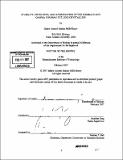| dc.contributor.advisor | Jonathan King. | en_US |
| dc.contributor.author | Mills-Henry, Ishara Amenti Rakem | en_US |
| dc.contributor.other | Massachusetts Institute of Technology. Dept. of Biology. | en_US |
| dc.date.accessioned | 2007-08-29T20:37:03Z | |
| dc.date.available | 2007-08-29T20:37:03Z | |
| dc.date.copyright | 2007 | en_US |
| dc.date.issued | 2007 | en_US |
| dc.identifier.uri | http://hdl.handle.net/1721.1/38627 | |
| dc.description | Thesis (Ph. D.)--Massachusetts Institute of Technology, Dept. of Biology, 2007. | en_US |
| dc.description | Includes bibliographical references (v. 2, leaves 189-208). | en_US |
| dc.description.abstract | The transparency of the human eye lens depends on the properties of the a- crystallin and py-crystallin families of proteins, which accumulate to very high concentrations in mature lens fiber cells. The 0- and y-crystallins are thought to be primarily structural proteins while a-crystallin possess an additional chaperone activity. Aggregation of partially unfolded or covalently damaged forms of these proteins results in cataract, which is the leading cause of blindness in the world. The biochemical basis of the very high crystallin stability, and the nature of the misfolded, modified, or aggregated states, are thus of considerable importance in understanding the etiology of loss of lens transparency. All vertebrate P- and y-crystallins are homologous and contain two highly symmetrical domains with a hydrophobic interface connected by an interdomain linker. The overall sequences, fold topology, and domain interfaces of vertebrate py-crystallins are highly conserved. The two domain 0- and y-crystallins are believed to have evolved by gene duplication and fusion from an ancestral single domain py-crystallin. This thesis is focused on stability and aggregation properties of human yD crystallin (yDwT) and human yS crystallin (ySwT), two of the most abundant proteins in the human lens. | en_US |
| dc.description.abstract | (cont.) Terminally differentiated fiber cells in the central nucleus of the lens are enucleated and devoid of organelles. The yD crystallins synthesized in utero must remain stable and soluble throughout life. The yS protein is more prevalent in the cortical regions of the lens, where protein degradation and synthesis do occur. Given the importance of long-term solubility for the crystallins, it seems likely that selection for the two-domain form is related to the need for very long-term stability. Comparison of the stabilities of the isolated domains and the intact protein indicated that the domain interface contributes a AGH20 of~ 4.2 kcal*mol-l to the stability of the complete yDwT two-domain protein. The differential stability observed for the yD isolated domains was not as distinct for the yS isolated domains. These results support the idea that selection for increased thermal stability was one of the factors leading to the evolution of two domain crystallins. A distinct hysteresis occurs during equilibrium unfolding and refolding, due to a kinetic barrier in the unfolding pathway. By extrapolating kinetic unfolding results from denaturing GuHCl concentrations to buffer, I show that the ti2 for the initial unfolding step is -19 years. The value extrapolated for the YSwT is not as long, though still significant. This supports the earlier conclusion that the domain interface is an important source of stability. | en_US |
| dc.description.abstract | (cont.) Previous studies had shown that upon dilution from denaturant partially folded intermediates of yD crystallin formed highly ordered fibrous aggregates that were not amyloid in nature. This aggregation reaction of yDwT polypeptide chains competing with productive refolding provided a model for cataractogenesis in vitro. The structurally homologous ySwT crystallin did not exhibit an off-pathway aggregation under the same conditions as yDwT. This suggested that the pathway of aggregation involved specific amino acids or sequences essential for association and was not a general feature of the y- crystallins. To investigate this disparity between two structurally similar crystallins, chimera proteins were created in an attempt to narrow down regions of the protein that promoted aggregation in DwTr or regions in ySwT that inhibited aggregation. The aggregation behavior upon refolding was analyzed for the chimeras and isolated single domains. Partitioning of refolding chains into the aggregation pathway was strongest for the full-length proteins that retained the yD interface. This result is consistent with a domain swapping mechanism for the off-pathway aggregation of the crystallins. This aggregation reaction may be coupled to the increased stability of the yD-protein, as a kind of evolutionary cost of the extremely stable and long-lived native state conformation. | en_US |
| dc.description.statementofresponsibility | by Ishara Amenti Rakem Mills-Henry. | en_US |
| dc.format.extent | 2 v. (219 leaves) | en_US |
| dc.language.iso | eng | en_US |
| dc.publisher | Massachusetts Institute of Technology | en_US |
| dc.rights | M.I.T. theses are protected by copyright. They may be viewed from this source for any purpose, but reproduction or distribution in any format is prohibited without written permission. See provided URL for inquiries about permission. | en_US |
| dc.rights.uri | http://dspace.mit.edu/handle/1721.1/7582 | |
| dc.subject | Biology. | en_US |
| dc.title | Stability, unfolding, and aggregation of the gamma D and gamma S human eye lens crystallins | en_US |
| dc.type | Thesis | en_US |
| dc.description.degree | Ph.D. | en_US |
| dc.contributor.department | Massachusetts Institute of Technology. Department of Biology | |
| dc.identifier.oclc | 156998006 | en_US |
